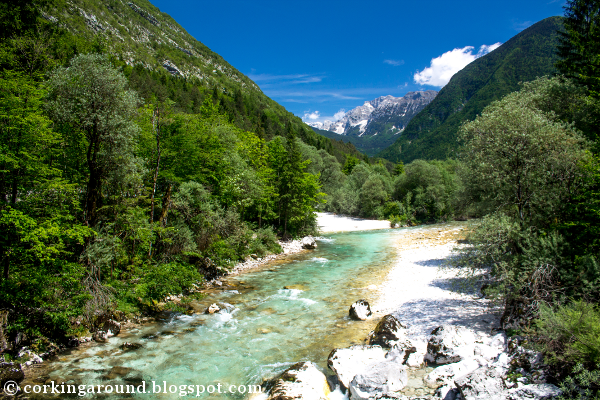Adriatic Adventure: Slovenia, Part 1 of 3
Our next stop after Venice was the Soča River Valley and Vršič Pass in Slovenia. We picked up our rental car at Venice airport, where we were blessed to be given an automatic, and went on our merry way. We used our handy Rick Steves Croatia and Slovenia guidebook to help us pick good stopping points along the way.
First we drove through the Soča River Valley. During WWI this area was the Soca (Isonzo) Front where hundreds of thousands of soldiers lost their lives. We drove through the small towns of Kobarid and Bovec before making our first stop at the Bunkerji suspension bridge over the Soča River. This was a beautiful stop with the Julian Alps and lush vegetation as a backdrop for the crystal clear water.
Next we stopped at the Church of St. Joseph, which is just beyond Bunkerji on the left-hand side of the road. Rick Steves describes the church as having a red onion dome tucked behind a big tree, but we were very confused when we didn't see anything that resembled an onion-like dome. If the description about it being behind a big tree hadn't been included we likely would have left still confused!
Once we figured out that the only building behind the tree actually was the church, we ventured inside. During WWII an artist who hid in the mountains filled the church with patriotic symbolism. The interior of the church is painted red, white, and blue and the ceiling has St. Michael with the former Yugoslavia's WWII enemies at his feet: the eagle (Germany), the wolf (Italy), and the serpent (Japan). But that's not all! The artist even included the faces of some of Yugoslavia's enemies, Hitler and Mussolini, in the Stations of the Cross.
Behind the church is a WWI cemetery, or the final resting place for several hundred Austro-Hungarian soldiers who were killed in action. There aren't many grave markers left, but an information sign on site depicts the cemetery's transformation over the years.
Next we stopped at Kamba in Trenta for lunch. Here we experienced our first Slovenian beer and enjoyed a delicious pizza!
After our drive through the Soča River Valley we entered Triglav National Park to start exploring the Vršič Pass in the Julian Alps. Triglav National Park is the only national park in Slovenia and is named after Triglav ("Three Heads"), the highest mountain in the country and its national symbol.
Here is the park's namesake, Mt. Triglav.
The Vršič Pass, which has an elevation of 5,285 ft (1,611 m) intersects Triglav National Park and is home to some 50 hairpin turns. This road was built in 1915 by Russian prisoners of war during WWI in order for the Austro-Hungarians to be able to supply their troops. Since the road needed to remain passable during the winter months, base camps were established to maintain the pass.
In March 1916 there was an avalanche that destroyed one of the base camps, killing several hundred prisoners and some of their guards. To commemorate these Russian soldiers a Russian Orthodox Chapel was built around hairpin 42 (if you're traveling north on the Vršič Pass from Trenta). In July 2006 the Vršič Pass was renamed Ruska cesta (Russian Road) to honor the Russian prisoners of war who were forced to build it.
Unfortunately while in the Julian Alps we had no time for hiking as we had to continue on our way to Lake Bled, a lovely lake-side town. But we did enjoy the stunning views and history of the Soča River Valley and the Vršič Pass. Stay tuned for Slovenia, Part 2: Lake Bled!










Comments
Post a Comment